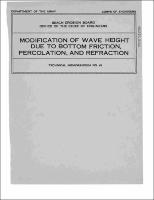Please use this identifier to cite or link to this item:
https://hdl.handle.net/11681/3372Full metadata record
| DC Field | Value | Language |
|---|---|---|
| dc.contributor | Texas A & M University | - |
| dc.contributor | United States. Army. Office of the Chief of Engineers | - |
| dc.contributor.author | Bretschneider, Charles L., 1920- | - |
| dc.contributor.author | Reid, Robert O. | - |
| dc.date.accessioned | 2016-03-16T15:42:17Z | - |
| dc.date.available | 2016-03-16T15:42:17Z | - |
| dc.date.issued | 1954-10 | - |
| dc.identifier.uri | http://hdl.handle.net/11681/3372 | - |
| dc.description | Technical Memorandum | - |
| dc.description | From the Preface: One of the more important phases of the study of the effects of waves on the shore is the modification of the wave trains as they approach the shore through shallow water. This report is on a theoretical investigation of the transformation (including energy loss) of waves in shallow water by bottom friction, percolation, refraction, and shoaling. Using the dissipation functions introduced by PUTNAM and JOHNSON, (1949) and PUTNAM (1949), derived from the theory of progressive oscillatory waves of small amplitude, a general solution of the steady state energy equation is obtained. This solution avoids the tedious process of successive approximations but does involve numerical integration for complex situations of bottom topography. For the case of a bottom of uniform slope and the case of a bottom of constant depth, the solutions are presented in convenient graphical form. The graphs make it possible to obtain the reduction factor due to friction or percolation for any bottom slope, depth, initial wave height or wave period, assuming the friction factor and permeability coefficient for the bottom are known. The use of the graphs is illustrated by checking the examples given by PUTNAM and JOHNSON (1949). An example which involves refraction is also presented. A field investigation on this subject has been underway at the Agriculture and Mechanical College of Texas under a Beach Erosion Board contract. The results of the field study will appear as Technical Memorandum No. 46 of the Beach Erosion Board. | - |
| dc.publisher | United States, Beach Erosion Board | - |
| dc.publisher | Engineer Research and Development Center (U.S.) | - |
| dc.relation | http://acwc.sdp.sirsi.net/client/en_US/search/asset/1007660 | - |
| dc.relation.ispartofseries | Technical memorandum (United States. Beach Erosion Board) ; no. 45. | - |
| dc.rights | Approved for Public Release, Distribution is Unlimited | - |
| dc.source | This Digital Resource was created from scans of the Print Resource | - |
| dc.subject | Water waves | - |
| dc.subject | Shallow water | - |
| dc.subject | Energy loss | - |
| dc.subject | Wave transformation | - |
| dc.title | Modification of the wave height due to bottom friction, percolation, and refraction | - |
| dc.type | Report | en_US |
| Appears in Collections: | Technical Memorandum | |
Files in This Item:
| File | Description | Size | Format | |
|---|---|---|---|---|
| BEB-TM-45.pdf | 16.53 MB | Adobe PDF |  View/Open |